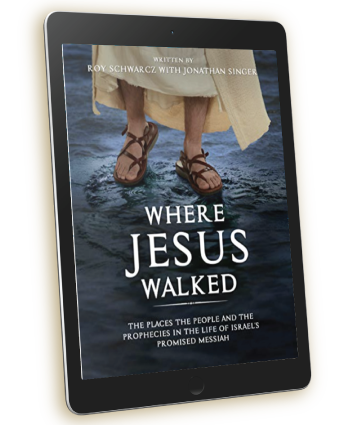V 1-2 The vision recorded by Daniel came to him when he was about 68 years of age, for he was taken captive (at about the age of 16) 52 years earlier in 605 B.C. The dream refers to his being asleep, and the visions refer to what he saw while dreaming.. Because of it significance he immediately wrote down a summary of it.
Daniel had already interpreted two significant dreams by Nebuchadnezzar (chap. 2; 4). Daniel first saw the great sea churned by the four winds. The word translated “winds” may also be rendered “spirits,” that is, angels.
In Scripture this word is also used to refer the work of angels (Jeremiah 23:19; 49:36; 51:1; Zechariah 6:1-6; 7:14; Revelation 7:1-3). Throughout the Old Testament the Mediterranean Sea is referred to as the Great Sea (Numbers 34:6-7; Joshua 1:4; 9:1; 15:12, 47; 23:4; Ezekiel 47:10, 15, 20; 48:28).
Which leads most to believe that the events describe have to do with nations surrounding the Mediterranean Sea, though sea is a word also used in Scripture to refer to the nations of the world (Revelation 17:1, 15).
V 3-4 – The second thing Daniel saw in the vision was four great beasts coming from the sea. In Revelation 13:17 we are told that these four beasts represent four kingdoms. This corresponds to Revelation 13:1-2. The first beast was like a lion, an animal know for its power and strength. This lion had eagle’s wings, which speaks of the ability that Babylon had of moving its army which was the source of its power and strength, speedily. The lion and eagle were both symbols of Babylon (Jeremiah 4:7, 13; Ezekiel 17:3).
The removal of the wings may speak of the empire’s deterioration after the death of Belshazzar, or as some suggest the humbling of Nebuchadnezzar when he became insane, as a result of God’s judgment on him when he became proud and did not give glory to God for his power. The lion’s rising up on two feet made it look more like a man. The fact that it got a man’s heart suggests that the animal lost its beastly nature and showed compassion. This may speak of the conversion of Nebuchadnezzar and that he was given a new heart, a heart of flesh (Ezekiel 36:26). The lion represents the Babylon which was the head of gold in the image of Daniel 2.
V 5-6 – The second beast was like a bear, which is an animal of great strength (1 Samuel 17:34; Amos 5:19; Hosea 13:8). This represents Medo-Persia, the empire that followed Babylon and was represented by the arms of silver in the Daniel 2. The Medo-Persian army was strong and cruel (Isaiah 13:15-18).
The three ribs in the bear’s mouth may represent the kingdoms of Egypt, Assyria, and Babylon, which had preceded the empire represented by the bear. Or they may represent Babylon, Lydia, and Egypt, three nations conquered by the Medes and Persians. The bear was told to devour flesh as Isaiah described in his prophecy. This command reminds us that governments and kingdoms are raised up and instituted by God for His purposes.
The third beast was like a leopard, an animal noted for its swiftness (Habakkuk 1:8), cunning, and agility (Jeremiah 5:6; Hosea 13:7). This beast is described as having four wings and four heads. The kingdom that conquered Medo-Persia was Greece, which did so with great speed, conquering the entire empire between 334 and 330 b.c. A few years after Alexander died his kingdom was divided into four parts having four different heads which were the four key generals of Alexander (Daniel 8:8, 22).
Cassander took Macedonia; Lysimachus took Asia Minor; Seleucus took Syria, out of which came the ” little horn ” of Daniel 8, Antiochus Epiphanes, who defiled the temple in Jerusalem, and is the central figure in the events surrounding Hanukkah; and finally, Ptolemy took Egypt, and of course, Cleopatra came along later in that line.
V 7-8 The fourth animal is simply called a beast which corresponds to the beast in Revelation 13:2. This fourth beast was more powerful and crueler than the three preceding beasts. This beast had large iron teeth with which it was able to crush and devour its prey. The empire represented by this beast crushed and assimilated into itself the three previous empires described by the lion, the bear, and the leopard (it trampled underfoot whatever was left; Daniel 7:19). The ten horns correspond to the feet of the image with ten toes of iron and fired clay of Nebuchadnezzar’s image. According to verse 24 they represent 10 kings which we learn more about in verses 19–28.
Like the image of Daniel 2 more attention is given to the fourth beast than to all of the other three put together. All the other beasts have counterparts in creation but this unlike any other created animal. This beast is characterized by strength. It had great iron teeth, which further identifies it with the beast of Daniel 2. As Daniel considers the horns, he saw another horn emerge among the 10. This little horn had an insignificant beginning but it was uproots three of the existing horns. This little horn had the eyes of a man and made great claims which we will also learn more of in v 19-28.
V 9-12. The scene shifts to heaven, and the throne of God is revealed. This is the same scene described in chapters 4 and 5 of the Book of Revelation and Isaiah (Isaiah 43:13; 57:15). Thrones of judgment are set up and one is occupied by the Ancient of Days, the Lord who is Sovereign over all men and nations. His white clothing and hair speak of His holiness (Revelation 1:14). The throne is ablaze and brings to mind what Ezekiel saw in his vision (Ezekiel 1:4-28).
Daniel saw God in his role as Judge take His seat and the books were opened. In Revelation 20:12 the opening of books refers to a review of the lives the men have led and judging of one’s stewardship. This is not the Great White Throne judgment which occurs after the Millennium, but is the setting for the judgment of the Great Tribulation and the return of Christ to establish His millennial kingdom here upon earth (Matthew 25: 31ff.).
The Lord judges the little horn because of its boasting (Revelation 13:5–6) and Daniel sees that the fourth beast was slain and consigned to blazing fire. The appearance of ” the little horn ” is shortly before Christ comes to judge living nations and individuals. This period equates the Great Tribulation Period. This event heralds the end of “the times of the Gentiles” (Luke 21:24, 27). The three other kingdoms represented by the lion, the bear, and the leopard were removed from power by military defeats. But the fourth beast will be lose its power by the judgment of God (Daniel 9:27; Revelation 11:15; 19:15).
V13-14. In the third scene in his dream or vision Daniel saw the Son of Man approaching the Ancient of Days. Yeshua spoke of His title “Son of Man” from this prophecy, the power that had been given to the rulers on the earth including the four kingdoms (cf. Daniel 3:4, 7; 4:1; 5:19; 6:25) was transferred to Him and all peoples worshiped Him.
Here is a very clear-cut statement that the Lord Jesus is that ” stone cut out without hands ” which strikes the image of Daniel 2 and thus He will establish His kingdom here upon earth. This was the Father’s promise to the Son in Psalm 2:6-9, and will be fulfilled when Jesus returns to establish His Kingdom on earth. (Matthew 24:30; 25:31; Revelation 11:15). His kingdom will never be end. At the end of the 1,000 year millennial reign, He will surrender the kingdom to God the Father, after which Christ will be appointed as Ruler over God’s eternal kingdom forever (1 Corinthians 15:24-28).
V 15-18- Daniel was distressed by this dream. Probably because he could not interpret it so he asked the angel in his vision, later identified as Gabriel (8:16; 9:21), to interpret the vision to him. It was explained that the four great beasts represent four kingdoms. The saints will take the kingdom, and possess it for ever and ever. Who are these saints? There are five verses in this chapter which mention them ( vv. 21–22, 25, 27).
Reference to them occurs again in Daniel 8:24. One school of prophetic interpretation assumes they are New Testament saints.
Exodus 19:6 identifies Israel as the holy nation or saints, The Greek word for ” saints ” is hagios, and it occurs two hundred times in the New Testament. Ninety-two times hagios is translated ” holy ” in combination with ” spirit, ” for the Holy Spirit. It is also used to speak of believers in the church who are called ” saints ” or ” holy ones. ” In the New Testament, ” saints ” are the sinners who have been declared righteous because of their faith in Christ (see Romans 1:7). Hagios is used likewise for Old Testament believers (see Matthew 27:52–53) and for tribulation saints (see Revelation 13:7). It is likely that ” the saints ” refer to people of Israel, the believing remnant. The reason is that Daniel is never given any insight into the era we are in that was a mystery not revealed until Paul received it (Ephesians 3).
V 19-22 Daniel seems most concerned about the fourth beast and so he asks the angel to interpret the meaning of the beast and its 10 horns and particularly the little horn. The little horn becomes the focus of the rest of his vision. The little horn came after the 10 horns (kings; v. 24) were in existence. It removes 3 of the 10 horns (kings). Daniel is told that he will persecute the saints of the Most High.. As in verse 18, the saints refer to the believing Israelis in the Tribulation. He will overcome the nation of Israel and will bring them under his authority (Revelation 12:13-17; 17:7). He will be judged by God (Revelation 19:19-20), and Israel will enter into her covenanted blessings in the kingdom.
V 23-25 The power of this coming ruler in the fourth kingdom will be worldwide. Daniel was told that this empire will devour the whole earth (Rev. 13:7). This is what causes prophecy scholars to believe that he will bring a one-world rule under a worldwide dictator. The angel then tells us the meaning of the 10 horns, that they are 10 kings in this kingdom. Sometime after the rise of these 10 horns, we don’t know how long, another king (the little horn, 7:8, 20) will arise.
In his rise to power he will subdue 3 kings (called 3 horns in v. 8), that is, he will bring 3 of the 10 nations under his authority in his rise to power. He will oppose God’s authority. He will speak against the Most High (Revelation 13:6). He will oppress His saints, and will abandon all previous laws and institute his own system.
He will in the early stages of his rise to power appear as Israel’s friend, but will become Israel’s persecutor and will occupy Jerusalem as the capital of his empire (11:45) for three and one-half years (Revelation 12:6; 13:5). A time, times, and half a time (Daniel 12:7; Revelation 12:14) refer to the three and one-half years of the Great Tribulation, with “a time” meaning one year, “times” two years, and “half a time” six months. This equals the 1,260 days in Revelation 12:6 and the 42 months in Revelation 11:2; 13:5.
V 26-28. When the God the Father judges the little horn, his power will be removed and he will be destroyed (v. 11; 2 Thessalonians 2:8; Revelation 19:20). This will occur at the Second Coming of Christ. At the beginning of the Millennium the Son of Man will be given authority to rule (Daniel 7:14), and He will rule over the saints, the people of the Most High and the world as the nations will come to Jerusalem at least annually to worship the Lord (Zechariah 14:16-17). This kingdom will continue in the Millennium and on forever (Daniel 4:34; 6:26; 7:14). This vision of the times of the Gentiles was so awesome to Daniel that he did not share the vision with anyone at the time. But later he wrote the prophecies in this book.


